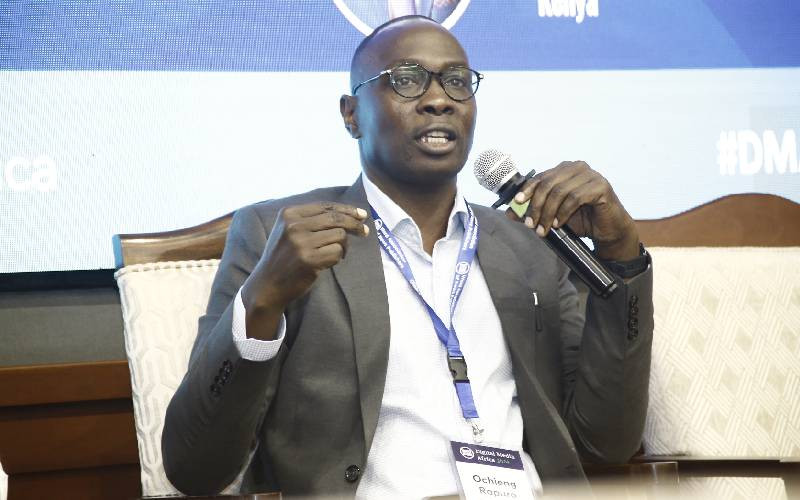
Standard Group Editor in Chief Ochieng Rapuro during the WAN-IFRA's Digital Media Africa conference at Aga Khan University, Nairobi, on September 19, 2024. [Kanyiri Wahito Standard]
Unlocking new revenue streams for media houses in light of shrinking government advertising took centre stage, during the second day of Digital Media Africa conference held in Nairobi.
Delegates at the conference organised by World Association of News Publishers (WAN-IFRA) heard that the dwindling revenue streams in Kenya, for instance, is a result of failure by the government to advertise with mainstream media houses.
It also emerged that the impact of social media has also led to the emergence of citizen-journalism, further compounding competition with the traditional media.
The meeting that was held at Aga Khan University and which attracted over 200 editors and heads of African and foreign media organisations, heard that there is need to diversify revenue streams for publishers to mitigate the dwindling fortunes.
Frank Aigbogun, publisher of Business Day in Nigeria, proposed that media houses should target Business to Business(B2B) clients subscription more than the individuals.
“Big foreign media houses like The New York Times have capitalised on that and currently over 60 per cent of their revenues are from the B2B model. We also have gone that way and we sell bulk to them and now, they contribute 65 per cent of our revenues. I advise other media houses to imitate that,” said Aigbogun.
Another source of revenue, delegates heard, are conferences and events held in collaboration with corporate entities like banks, companies.
Aigbogun said these methods have led to revenue growth from 32 per cent to nearly 40 this year. He said this year alone, they are presently doing 38 events, which have high attendance.
Standard Group Editor in Chief Ochieng Rapuro said there is need for media houses to play the role of demanding for accountability, which the company has been doing, including recent two weeks’ analysis of President William Ruto’s two years in office.
Mr Rapuro said there were threats from the government against media houses doing live coverage of protests. But on the flipside, Rapuro said President’s William Ruto’s reaction to the protests presented an opportunity for the media to attract audience.
“The media interview with the President in the wake of protests restored trust in legacy media by the GenZ. We had positive traction that saw increased traffic by 30 per cent on our website, 20 per cent increased subscription, and tripled YouTube viewership. However retaining and sustaining the trend has become a challenge,” he said.
Pulse managing director Jack Owega said there is need for media houses to partner with giant social media apps to help generate revenue through sharing their content.
While presenting on Digital Advertising; Move Beyond Selling Reach, Owega said his media house has partnered with Tiktok, which helped them make revenue.
He urged media houses to avoid focusing on rate cards in all situations but calculate the cost of carrying out the job and know the margin.
Using short videos for news also emerged as another revenue line that can be exploited by media houses. This method, delegates heard, is now preferred by young audiences.
The conference comes at the time when consumption of news from traditional media is changing based on consumers’ behaviour, threats from technological advancement such as Artificial Intelligence (AI), that could lead to job losses, closing down media houses and shrinking revenues due to digital migration.
The meeting also discussed digitisation, impact of AI, and digital advertising.
Understanding the audiences, format and distribution was also discussed at the event, which presented an opportunity to discuss many issues affecting the media industry in the continent today.
Other themes discussed at the two-day meeting were the digital future we need, how to implement AI in media companies and the ethical considerations, a workshop on AI in action and utilising Google Pinpoint for investigative journalism.
Also forming discussions were how to connect with and invest in the younger generations, next gen news: understanding the audiences of 2030, format and distribution.
On whether traditional media rose to the occasion during the recent Gen Z protests, Joe Ageyo, the editor in chief at the Nation Media Group said the live coverage of the protests on TV was a challenge, especially after they were infiltrated by goons who looted, making them not peaceful anymore.
“This gave us challenges especially on balancing between ethical guidelines and covering real issues the protesters were raising, thus attracting condemnation from the government,” Ageyo said.

